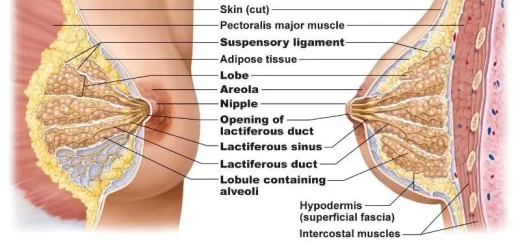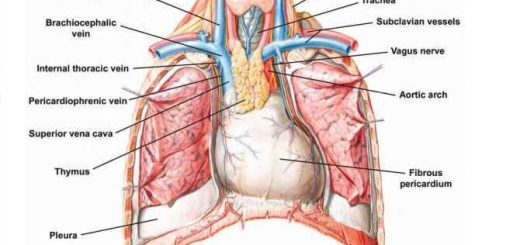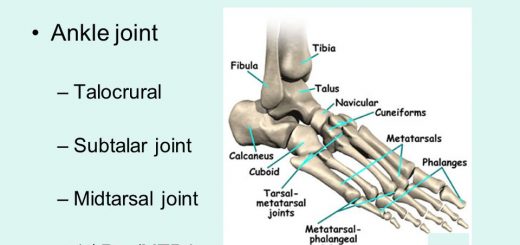Cranial cavity anatomy, function, structure, Dural folds, Cavernous sinus and Nerve supply of scalp
The cranial cavity is the space within the skull that accommodates the brain, It is known as intracranial space, It is the space formed inside the skull, It is formed by eight cranial bones known as the neurocranium that in humans includes the skull cap & forms the protective case around the brain, Eight fused cranial bones together form the cranial cavity: the frontal, occipital, sphenoid, and ethmoid bones, and two each of the parietal and temporal bones.
Anatomy of the cranial cavity
The dura mater lines the inner aspect of the skull cap and the cranial cavity, It protects the brain from shocks and friction with the hard skull, The dura is composed of 2 layers:
- Outer (endosteal) layer, lines the brain box.
- Inner (meningeal) layer covers the brain.
The two layers are closely adherent to each other, They are only separated to form dural venous sinuses, Dural venous sinuses are:
- Valveless veins.
- Receive venous blood from the orbit, brain, and adjacent skull bones.
- Present between the two layers of the dura.
- Their walls are devoid of muscular tissue.
The inner layer of the dura forms 4 folds inside the cranial cavity.
Dural folds
I. Falx cerebri: a sickle-shaped fold, lies between the two cerebral hemispheres.
Attachments:
- Anterior: crista galli & frontal crest.
- Posterior: upper surface of tentorium cerebelli.
- Superior: to the lips of the sagittal sulcus on the inner aspect of the skull cap.
- Inferiorly; it has a lower border which is concave and free.
Venous sinuses related to it:
- Superior sagittal sinus in its upper attached border.
- Inferior sagittal sinus in its free concave lower border.
- Straight sinus in the attachment of the falx cerebri with the tentorium cerebelli.
II. Tentorium cerebelli: a tent-like fold that covers the cerebellum.
Attachments:
- The attached margin (peripheral) is attached to the posterior clinoid process, upper border of the petrous temporal bone, and to the margin of the transverse sulcus on each side.
- The free margin: attached anteriorly to the anterior clinoid process, It forms a tentorial notch around the midbrain, This margin crosses the attached one at the petrous apex, The trochlear nerve pierces the dura at the point of crossing, while the oculomotor nerve pierces the dura in front of the crossing point, The upper surface gives attachment to the falx cerebri, while the lower surface gives attachment to the falx cerebelli.
Venous sinuses related to it:
- Straight sinus (between the attachment of the falx cerebri and the upper surface of the tentorium).
- Superior petrosal sinus in the attached margin along the upper border of the petrous temporal bone.
- Transverse sinus in the attached margin along the transverse sulcus.
III. Falx cerebelli: a small crescentic fold between the two cerebellar hemispheres.
- Attachments: to the internal occipital crest and the inferior surface of the tentorium cerebelli.
- Venous sinuses related to it: occipital sinus and straight sinus.
IV. Diaphragma sellae: a dural fold covering the pituitary gland in the hypophyseal fossa, It is pierced by the pituitary stalk.
Attachments: it is attached to the anterior and posterior clinoid processes.
Venous sinuses related to it:
- Anterior: anterior intercavernous sinus.
- Posterior: posterior intercavernous sinus.
Dural venous sinuses
Single:
- Superior sagittal.
- Inferior sagittal.
- Straight sinus.
- Inter-cavernous.
- Basilar plexus of sinuses.
- Occipital.
Paired:
- Spheno-parietal.
- Cavernous.
- Superior petrosal.
- Inferior petrosal.
- Transverse sinus.
- Sigmoid sinus.
Superior sagittal sinus (SSS)
It begins at the apex of falx cerebri above the crista galli and ends a little to the right of the internal occipital protuberance by turning to the right side and continues as the right transverse sinus, It may open into a dilatation called the confluence of sinuses at the internal occipital protuberance.
Inferior sagittal sinus (ISS)
It runs along the posterior half or two-thirds of the free margin of the falx cerebri. It is of a cylindrical form, increases in size as it passes backwards, and ends at the free margin of tentorium cerebelli by uniting with the great cerebral vein to form the straight sinus.
Straight sinus (SS)
It is found at the line of junction of the falx cerebri with the tentorium cerebelli, It is formed by the union of the inferior sagittal sinus and the great cerebral vein, It terminates at the internal occipital protuberance by forming the left transverse sinus, It may open into the confluence of sinuses.
Transverse sinus
It begins at the internal occipital protuberance as follows: The right sinus is usually bigger than the left because it is usually the continuation of the superior sagittal sinus, The left sinus is usually the continuation of the straight sinus.
Sigmoid sinus
It begins as a continuation of the transverse sinus, It ends by passing through the posterior compartment of the jugular foramen to continue as the internal jugular vein.
Intercavernous sinuses
They are usually two in number; anterior and posterior sinuses, They connect the two cavernous sinuses across the middle line, The anterior passes in the anterior border of diaphragma sellae, The posterior passes in the posterior border of diaphragma sellae, They form with the cavernous sinuses a venous circle (circular sinus) around the hypophysis cerebri.
Occipital sinus
It is the smallest of the cranial sinuses, It is situated in the attached margin of the falx cerebelli, It is usually single, but occasionally there are two, right and left sinuses, They arise from the right and left transverse sinuses, They fuse together to form a single sinus which ends into the sigmoid sinus in each side, It communicates around the margin of the foramen magnum by several small meningeal veins.
The cavernous sinus
- Position: on each side of the sphenoid bone in the cranial cavity. It extends from the superior orbital fissure anteriorly to the apex of petrous bone posteriorly.
- Size: two cm long and one cm wide.
Relations:
- Roof: base of the brain, diaphragm sellae, and internal carotid artery.
- Floor: body of sphenoid and sphenoidal air sinus.
- Medially: pituitary gland, body of sphenoid bone, and sphenoidal air sinus.
- Laterally uncus of the temporal lobe of the brain, and the trigeminal ganglion.
Contents:
- In the lateral wall (from above downward): oculomotor (III), trochlear (IV), ophthalmic (V1), and maxillary (V2) nerves.
- Structures within the cavity of the sinus: the internal carotid artery and abducent (VI) nerve.
Tributaries:
- Superior ophthalmic vein.
- Inferior ophthalmic vein.
- Central vein of the retina.
- Spheno-parietal sinus.
- Superficial middle cerebral vein.
Communications:
- With the facial vein through the superior ophthalmic vein.
- With the cavernous sinus of the opposite side through intercavernous communications.
- With the pterygoid and pharyngeal plexus of veins through emissary veins passing through, foramen ovale or foramen lacerum.
Drainage:
- Through the superior petrosal sinus to end in the transverse sinus.
- Through the inferior petrosal sinus to end in the internal jugular vein.
Applied anatomy:
Infection of the cavernous sinus (cavernous sinus thrombosis) may be fatal. It could be transmitted to:
- The brain through the superficial middle cerebral vein.
- Eyeball (leading to edema of the eyeball and lids).
- It leads to the affection of the cranial nerves related to the cavernous sinus leading to squint (due to nerve irritation) or ophthalmoplegia (due to complete nerve compression).
- It leads to the affection of the internal carotid artery causing pulsating exophthalmos.
Anatomy of the scalp
The skin of the scalp extends from the eye brows anteriorly to the nuchal lines posteriorly and temporal lines on each side. The scalp is important clinically because trauma to the scalp is frequent and produces profuse bleeding, The scalp is made up of five layers:
- S – Skin.
- C – Connective tissue. It contains fat lobules, C.T. septa, and many blood vessels (which bleeds profusely if injured). This layer is called the vascular layer.
- A – Aponeurosis (galea-aponeurotica) and occipitofrontalis muscle.
- L – Loose areolar tissue. Bleeding in this layer is massive and my reach the eyelids causing black eyes.
- P – Pericraniom the outer periosteum.
Blood supply of the scalp: there are five arteries that supply the scalp:
- Supraorbital artery.
- Supra trochlear artery. These two arteries are branches from the ophthalmic artery which is a branch of the internal carotid artery.
- Superficial temporal artery.
- Posterior auricular artery.
- Occipital artery.
The later three arteries are branches of the external carotid artery, This means that the scalp is an important site of anastomosis between the external and the internal carotid arteries, The first three arteries supply the area of the scalp in front of the auricle, while the last two arteries supply the area of the scalp behind the auricle.
Nerve supply of scalp
- Motor: the scalp contains a muscle which is the occipito-frontalis muscle. This muscle is supplied by the facial nerve (VII) by its temporal branch anteriorly and the posterior auricular branch posteriorly.
- Sensory: the anterior part of the scalp (anterior to the auricle) is supplied by branches from the 3 divisions of the trigeminal nerve, The posterior part of the scalp (posterior to the auricle) is supplied by branches from cervical spinal nerves.
There are 4 nerves anterior to the auricle and 4 nerves posterior to the auricle:
- Anterior to the auricle: supratrochlear, supra-orbital (ophthalmic V1), zygomatico-temporal (maxillary V2), and the auriculotemporal (mandibular V3) nerves.
- Posterior to the auricle: great auricular, lesser occipital, 3rd occipital and greatet occipital nerves.
Occipito-frontalis muscle
It is formed of occipital and frontal bellies which are attached to the galea aponeurotica.
Nerve supply: the frontal belly of occipito-frontalis is supplied by a temporal branch of the facial nerve, while the occipital belly is supplied by the posterior auricular branch of the facial nerve.
Applied anatomy
Injury of the scalp may lead to its separation from the skull, This separation occurs at the loose areolar connective tissue layer (fourth layer), that is why this layer is considered as the dangerous layer of the scalp.
Skull function, anatomy, structure, views & Criteria of neonatal skull
Facial muscles function, anatomy, arteries, veins, names & expressions
You can subscribe to science online on Youtube from this link: Science Online
You can download Science Online application on Google Play from this link: Science Online Apps on Google Play



